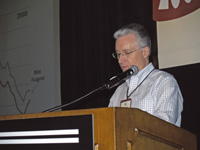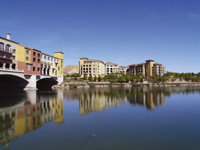APA members congregate in Las Vegas
10 December 2008Some 340 wood panel and other wood manufacturers and suppliers gathered at the annual APA
meeting, Las Vegas, Nevada in late September to hear some good news and some bad news.
The attendance total was only
slightly less than 2007 – somewhat
surprising in light of the financial and market conditions.
The good news was that perhaps the construction market employing wood might begin a slight trend upward next year. The bad news was that, at the time, the US financial markets were poised at a point perhaps rivalling the deplorable conditions of the 1930s.
Ironically, the APA was celebrating the 75th anniversary of its founding, dating back to the middle of those dark days.
Chairman Mike Rehwinkel, Georgia-Pacific Wood Products LLC, said, “The US housing market is the worst it’s been in a quarter century. The cost of oil hit record highs earlier this year. Inflation fears are growing. Builder and consumer confidence levels are low. And for most segments of our industry, production capacity is out of balance with
market demand”.
He said, “This is a difficult time in our long history, but we are far better off today than in 1933, when the association was founded during the Great Depression by ‘incurable optimists’.”
He said industry must continue to look to the future, even when preoccupied with the challenges of the present.
“We have good reason to be confident [because] we bring to the challenges significant strengths, including a tradition of toughness that marks our long history.
“And yet, we continue to adapt, to strategise, improvise, plan and execute...in short, to survive as an industry…and as an association. In addition to our pride in our history, we also as an organisation are confident in our future. We continue to work together on a number of important programmes and campaigns that promise to yield significant results for us down the road.”
“Let’s remain confident. Let’s continue to stick together. And let’s keep moving forward,he concluded.
Mr Rehwinkel reported the addition of seven new APA members over the past year for a total of 153. This includes 96 panel mills and 57 engineered wood plants. Twelve companies joined the Wood Technology Association for a total membership of 90.
Market forecasting is a difficult task in today’s market, but Dr Bernard Markstein, a fast-talking and dynamic speaker, led off on that responsibility. He is vice president for forecasting and analysis for the National Association of Home Builders.
He declared: “The fact that we are not in worse shape with all these problems [means something]. Housing is in a
21/2-year recession. We’re all feeling pain. There is a huge amount of inventory
out there.”
He said the turmoil in financial markets is feeding on itself. The demand needs to stabilise and improve before recovery.
He added: “We’ve never been here. We’re in uncharted territory. The closest was the Great Depression. The problems are largely of the financial market. There’s a lot of strength to our basic economy. Our forecast is for a mild recession, but it doesn’t matter whether there is a recession or not, it’s the condition of your business [that matters]”.
Dr Markstein predicted that single-family home sales will climb in 2009, but he said “Tough times are not over”.
He observed that single-family home prices dropped considerably in 2005-2007 and the formerly “hot marketsdropped the most. The inventory of unsold homes is still high. Multi-family has been relatively stable.
Through all this, he said, non-residential construction “has been a saviour, although it, too, has slowed. Multi-family housing starts have been fairly stable”.
He said new and existing home sales are still declining, but he believes they are close to bottoming out. NAHB expects a modest rebound in residential construction beginning early in 2009.
“I think we’re close to the bottom,he said. “There will still be pain and pressure. People will be stronger.”
The Info Fair with 60 exhibitors provided the opportunity for mill people to learn about the latest machinery and supplies for their industry. Ventek and Hexion Specialty Chemicals Inc drew Supplier of the Year awards for equipment, and materials and supplies categories, respectively.
Dowell Myers, University of Southern California, explained the expected rise in the ratio of seniors in the general population which could trigger a number of crises, including Social Security insolvency, Medicare and health insurance cost rises, workforce and taxpayer replacement challenges, maintenance of infrastructure and over-supply of home sellers.
He said: “I’m going long term. You can’t build a house if there is no one there to live in it. But we’re still growing big time. Growth will be in the older age group. Developers are all going into retirement housing”.
He indicated that the work force is in crisis with retirees leaving and growth slowing.
He said that immigration and a better educated, and therefore wealthier, younger generation could help avert those crises.
Education had a part in his predictions. He said college graduates will pay 64% more for houses than high school graduates. “We’re not helping these kids for their benefit. It’s for ours,said
Mr Myers.
He said the suburbs are America’s future slums with people moving to the cities. “Older folks want to live closer to more amenities,he declared.
APA vice-president and corporate secretary Ed Elias ruefully told attendees: “I wish times could have been better so that we might be in a more festive mood to celebrate APA’s 75th anniversary. But it underscores and reminds us of our remarkable success in meeting all sorts of previous challenges.
“We met those challenges before. We’ll meet them today”.
He explained the association’s strategic plan with five principal goals:
• Grow wood product share in major
end-use markets
• Increase APA membership
• Provide a certification programme which assures member compliance
with standards
• Exercise fiscal responsibility
• Maintain organisational effectiveness.
Mr Elias said emphasis will be placed on construction markets due to their sheer size and available funding from outside sources. Industrial and international markets represent growth opportunities as well and are also addressed.
He said APA had had high-level meetings with two major prospective members.
The certification goal assures members’ standards compliance. He said, “This underscores the vital link between market growth and product quality. At the same time it recognises the challenges faced by US manufacturers during these times of low market demand and excess capacity.
“An important aspect of the APA brand in the marketplace is recognition that the APA mark on your panels and other engineered wood products stands for product quality. And it is vital that we protect that credibility,Mr Elias advised.
He emphasised: “It is imperative that we take every effort to reduce spending, weigh the cost/benefit of all activities, leverage funding from outside sources and carefully monitor and forecast income and expenses”.
He said the board revised the budget to reduce expected income by 10%, or US$1.8m, reduced spending by the same amount and approved application of some outside funding to offset operational expenses.
Mr Elias added: “An important assumption is that current conditions are temporary, rather than permanent, and that the revised plan should be viewed as a bridge, rather than as a fundamental change in association direction.
“With this plan in place, with your continued strong support and with the eventual economic and housing market turnaround that is sure to come, our industry and your association have tremendous prospects ahead for success and prosperity,he concluded.
Keith Koonce, Panelized Structures Inc, advised on selling to the non-residential construction market.
He strongly advised using panelised roof construction for its safer installation methods and 60% time savings. He said a typical crew will put up 20,000ft2 per day in 8ft and 10ft sections.
He said his firm insulates on the bottom side in voids.
A discussion indicated rising interest in raised wood floors compared with concrete slab construction. APA has sponsored seminars on the subject in its important southern market.
Mr Koonce said wood has 80% of the roof market in the US west, but only 5% in the east, where steel makes up the vast majority, despite its much higher cost.
APA’s Charles Barnes estimated 2008 North American panel exports at 1.27 billion ft2, the best year on record and a record for North American OSB exports.
Tom Williamson, APA, reported that Arkansas regulations prohibiting wood in school construction had just been reversed and using wood in seven schools had saved US$2.5m.
Marilyn LeMoine, APA’s market communications director, reported on the association’s new comprehensive website which draws 100,000 contacts monthly.

